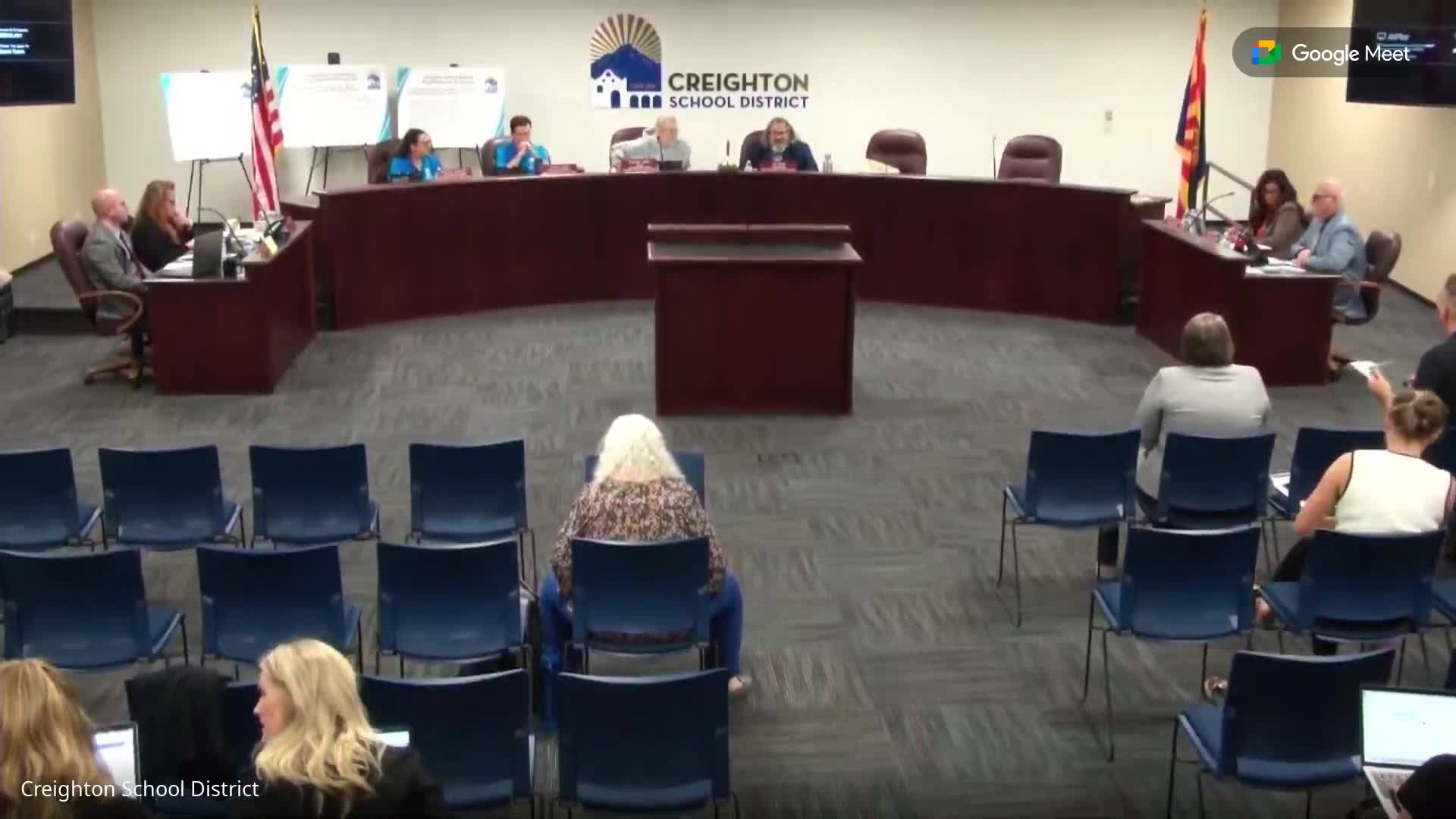Board approves revised teacher evaluation data distribution and administrator evaluation alignment
October 15, 2025 | Creighton Elementary District (4263), School Districts, Arizona
This article was created by AI summarizing key points discussed. AI makes mistakes, so for full details and context, please refer to the video of the full meeting. Please report any errors so we can fix them. Report an error »

The Creighton Elementary School District Governing Board on Oct. 21 approved revisions to the standard evaluation system for certified staff and adopted a revised administrator annual evaluation intended to align evaluations more closely with the district’s student‑outcomes focused governance framework.
Why it matters: The revisions change how the 33% data portion of a teacher’s overall evaluation is calculated (recommended shift from a 70/30 growth/achievement split to a 50/50 distribution) and adjust cut scores used to convert combined observation and data scores into final ratings. District staff and teacher representatives said the goal is to align evaluation metrics with board priorities and to make the data portion more reflective of the district goals.
Overview of changes presented: Assistant superintendent/assessment staff reviewed the recommended redistribution of the 33% data component to 50% growth and 50% achievement, and proposed changing final rating cut points (current cut scores at 25/50/75 moved to 40/60/80) to better reflect the new distribution. For K–2 achievement metrics the district will use the FastBridge 50th percentile spring measure; for grades 3–8 achievement the district will use DNA post‑test proficiency rates. Staff explained the recalculation using last year’s data to demonstrate the likely distributional impact on staff ratings.
Other recommendations included shifting first‑and second‑year teachers (new to the profession) to school‑level data rather than classroom‑level attribution, pausing academic progress plans in favor of a single plan option, and offering alternative evaluation pathways for teachers with three consecutive highly effective ratings (mentoring and system contributions instead of full observations).
Teacher perspective: Mercedes King, a teacher at Loma Linda who participated on the evaluation committee, told the board that teachers initially expressed concern at the change but found the proposed approach more understandable when staff translated the percentages into concrete classroom counts (for example, how many students equal 20% of a class). King emphasized the stakes around achievement metrics and the district’s role in supporting early interventions to avoid long‑term outcomes such as increased dropout risk.
Vote: The board moved and seconded the recommendation and voted to approve the revised standard evaluation system document and the administrator annual evaluation instrument. Trustees said the work included teacher focus groups and committee meetings to gather feedback.
What’s next: District staff will publish the standard evaluation system worksheet (“score compilers”), distribute documentation to teachers, and continue rollout of EduCLIMBER and DNA tiles so teachers can monitor student‑level data; the administration said further work on pay‑for‑performance design will proceed separately.
Sources: Presentation and Q&A during the Oct. 21 board meeting; evaluation committee focus group comments.
Why it matters: The revisions change how the 33% data portion of a teacher’s overall evaluation is calculated (recommended shift from a 70/30 growth/achievement split to a 50/50 distribution) and adjust cut scores used to convert combined observation and data scores into final ratings. District staff and teacher representatives said the goal is to align evaluation metrics with board priorities and to make the data portion more reflective of the district goals.
Overview of changes presented: Assistant superintendent/assessment staff reviewed the recommended redistribution of the 33% data component to 50% growth and 50% achievement, and proposed changing final rating cut points (current cut scores at 25/50/75 moved to 40/60/80) to better reflect the new distribution. For K–2 achievement metrics the district will use the FastBridge 50th percentile spring measure; for grades 3–8 achievement the district will use DNA post‑test proficiency rates. Staff explained the recalculation using last year’s data to demonstrate the likely distributional impact on staff ratings.
Other recommendations included shifting first‑and second‑year teachers (new to the profession) to school‑level data rather than classroom‑level attribution, pausing academic progress plans in favor of a single plan option, and offering alternative evaluation pathways for teachers with three consecutive highly effective ratings (mentoring and system contributions instead of full observations).
Teacher perspective: Mercedes King, a teacher at Loma Linda who participated on the evaluation committee, told the board that teachers initially expressed concern at the change but found the proposed approach more understandable when staff translated the percentages into concrete classroom counts (for example, how many students equal 20% of a class). King emphasized the stakes around achievement metrics and the district’s role in supporting early interventions to avoid long‑term outcomes such as increased dropout risk.
Vote: The board moved and seconded the recommendation and voted to approve the revised standard evaluation system document and the administrator annual evaluation instrument. Trustees said the work included teacher focus groups and committee meetings to gather feedback.
What’s next: District staff will publish the standard evaluation system worksheet (“score compilers”), distribute documentation to teachers, and continue rollout of EduCLIMBER and DNA tiles so teachers can monitor student‑level data; the administration said further work on pay‑for‑performance design will proceed separately.
Sources: Presentation and Q&A during the Oct. 21 board meeting; evaluation committee focus group comments.
Don't Miss a Word: See the Full Meeting!
Go beyond summaries. Unlock every video, transcript, and key insight with a Founder Membership.
✓
Get instant access to full meeting videos
✓
Search and clip any phrase from complete transcripts
✓
Receive AI-powered summaries & custom alerts
✓
Enjoy lifetime, unrestricted access to government data
30-day money-back guarantee

